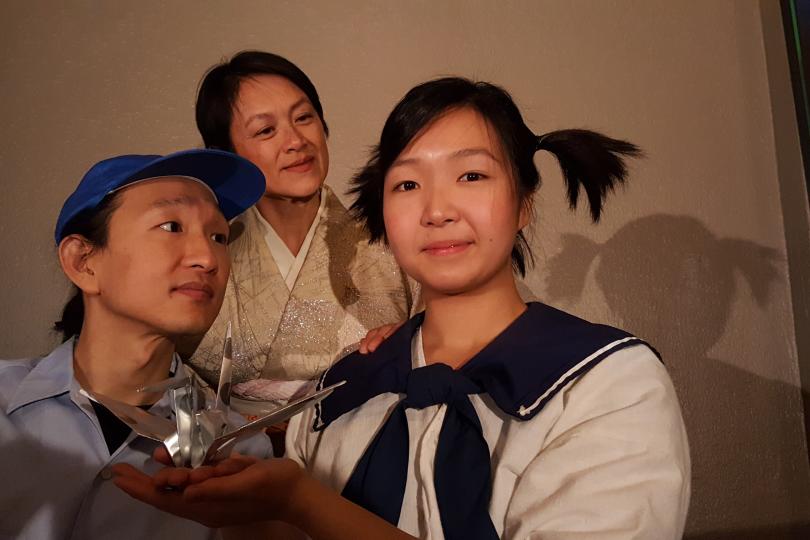A timely call for peace

What an eerily fitting time to retell Sadako Sasaki’s story. She was two years old when an American atomic bomb hit her home town of Hiroshima in 1945, and 12 when she died of leukemia triggered by radiation exposure from the bomb. Her life, and the thousand paper cranes she and her loved ones folded before her death, are international reminders of the effects of warfare.
The United States struck a Syrian airfield this week following a government-led chemical weapons attack against its citizens last Tuesday, killing at least 80, many of them children. So the chance to reflect on Sadako’s life through the play A Thousand Cranes was a sort of gift. With a steady history of producing plays, Green T managed to make grim subject matter uplifting and beautiful.
The show opened with actors playing traditional Japanese instruments to melodies composed by Miriam Gerberg. This set the tone perfectly for the immersive experience of Sadako’s life. Running in bouncy ponytails around Dreamland Arts’s stage as she practiced for a big school race, Sadako opened the show as a ball of energy. But one day, she collapses while out running and is rushed to the hospital. After being diagnosed, Sadako sets off to fold 1000 origami cranes, inspired by a Japanese legend that says anyone who folds that many cranes will be granted a wish. Visited by her best friend, her grief-stricken parents and the spirit of her grandmother, Sadako folds in hopes of getting well. But the clock ticks throughout. As cast members count into the hundreds and Sadako folds, she meets an early death like many who were touched by the bomb. (This story’s pretty well known. Believe me, it’s in the telling, and what happens after Sadako’s death that that makes this play special.)
Kathryn Schultz Miller’s script was refreshingly light of text, leaving plenty of room for movement and musical breaks. Director and choreographer Kathy Welch did not rush anything, letting the performers take us through these images with a calm grace. By telling the story from Sadako’s perspective, taking on a more innocent experience of the sickness and effects of the bomb, the script allowed the show to be extremely creative while remaining appropriate for all ages. (Hearing that the company has toured the show in Wisconsin for school groups made a whole lot of sense.) The play’s capacity to give older viewers a different experience just by knowing its context gave it an added weight.
Almost too polished
Green T has produced more than 30 shows, and it, well, shows. From crisp lighting to whimsically choreographed bits, they made excellent use of all technical elements. A highlight was when characters disappeared behind an opaque-seeming stage flat to reveal that it was a screen. Like human shadow puppets, actors used the screen to take on personas of the dead. Simple yet powerful tricks like this helped elevate the play beyond the small space it inhabited.
So did the acting. All three actors filled the stage, with Catrina Huynh-Weiss and Ki Seung Rhee switching between multiple roles. Their abilities made the story seem bigger than a three-person one. At the center of it, Sarah Tan channeled Sadako’s childlike physicality. Her endless jumping and shuffling reminded us this play was being told from the 12-year-old’s viewpoint. Scary puppets crashing in on her when she fell sick and (maybe a few too many) jokes about her best friend being a frog reinforced that too.
But despite the good acting and masterful use of the production elements — and despite Sadako’s fidgeting — the play lacked a youthful energy that could have taken it further. In creating such perfect images and farming the creativity out of every corner of the set, it was too put together to unravel. For how flawlessly it followed the formula, it’s a pity the play did not have more heart. As much as I would have liked the show to spark reflection and catharsis about recent events (and even more recent ones since I saw it on Thursday), it did not. Watching the innocent approach, the adult I have become did not get torn down by Sadako’s story in the way I was hoping I would. It left me searching for a solace that I don’t think any of us are going to find right now.
But it was an admirable effort, and at the center of the play was a message of peace. Sadako’s legacy lives on, and has very real importance right now. How many cranes will it take to make this wish come true?


